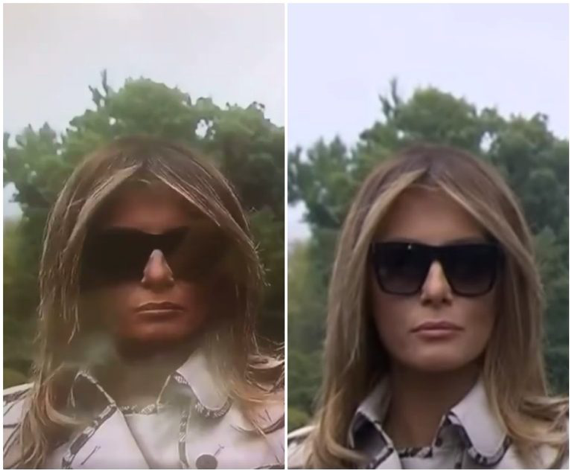By Jordan Taylor
Medieval Europeans understood Kings to possess two bodies: not only a human body that ached and slept and died but also a “body politic” that fulfilled a political and spiritual function for the state.[1] Twenty-first century Americans, in contrast, recognize little distinction between political leaders and their physical bodies. The President who inhabits the White House and fulfills the ceremonial functions of the office is also a human being who eats and dreams and farts.
In October 2017, though, a viral video convinced millions of Americans that First Lady Melania Trump had gone medieval. It claimed to show a “body double” of the First Lady appearing at a public event alongside President Trump. Indeed, the woman in the video looks a bit off. Her face seems oranger than usual and oddly compressed. But this was not evidence that the First Lady had outsourced her ceremonial functions to two Oompa-Loompas in a trench coat and a wig. In fact, the truth is much duller.
As the fact-checking site Snopes reported, the person who uploaded this video had simply recorded a malfunctioning television that distorted the First Lady’s image. Numerous photos and videos from that event clearly demonstrate that the real Melania Trump attended. Indeed, she seemed happy to be there.
Despite numerous corrections, the #FakeMelania story took on a life of its own. As of the time of this writing, the original video had garnered nearly twenty million views. It proved to be a durable falsehood, spreading through memes and jokes. On several other occasions, odd facial expressions or unflattering photo angles inspired further accusations. In March 2019, President Trump even responded with a tweet that accused the “Fake News” of photoshopping images of his wife. He concluded, “They are only getting more deranged with time!”
This deceptive story spread widely, in part, because it supported a broader narrative about President Trump that his critics enjoy. “President Trump repels even those closest to him,” these critics might suggest. “Look! His wife would rather hire a body double rather than spend time with him.” This piece of deception has fed from, and contributed to, a broader social media narrative surrounding Melania Trump. The meme “#FreeMelania” casts the First Lady as a prisoner who despises her husband. Likewise, a cordial moment between Melania Trump and Canadian Prime Minister Justin Trudeau in August 2019 inspired a wave of commentary suggesting that she preferred Trudeau to her husband.
In fact, when the First Lady has spoken for herself, she has affirmed her support for her husband and her disdain for his critics. Her spokeswoman Stephanie Grisham even wrote an op-ed for CNN.com arguing that “absurdity abounds in the media’s coverage of our first lady.”
How many of those who spread the “Fake Melania” story (whether by creating memes, sharing images and videos, or simply by clicking “Like” on a Facebook post) sincerely believed that it might be true? Some surely did. But many of those who have shared #FakeMelania posts on social media likely realized that the story lacked any foundation. Embedded in this larger #FreeMelania narrative, they may have spread this viral deception for laughs or to communicate what they viewed as a larger truth about President Trump’s character.
Yet this would not be obvious to everyone who encountered this story. Social media posts often take root in several layers of unspoken context. In a certain network of users, someone posting a “Fake Melania” meme might be understood to be asserting a symbolic truth without making a factual assertion. Social media platforms, though, also make it easy to strip away this kind of context.
When President Trump blamed the “Fake News” media for the Melania body double story, he elevated the story from a silly internet meme that may have duped some people into an intentional work of character assassination. Some of his followers might have surmised that President Trump’s opponents had fallen for this easily-disprovable lie. Others may have concluded that this was a conspiracy among media elites to defame the First Lady.
There’s only one Melania Trump. But there are thousands, perhaps millions, of social media users who might claim otherwise. The rapid spread and elevation of the Fake Melania story demonstrates how outrageous hoaxes spread more quickly than truths. But it also demonstrates the extent to which many social media users have grown indifferent to truth and the consequences of that indifference. When Americans develop a casual relationship to truth, they shouldn’t be surprised when they’re accused of perpetrating “fake news.”
Notes:
[1] Ernst H. Kantorowicz, The King’s Two Bodies: A Study in Medieval Political Theology (Princeton: 1957).
